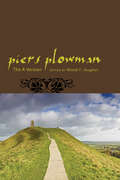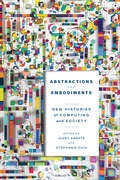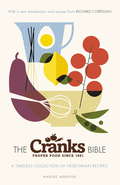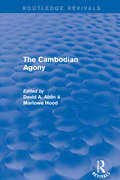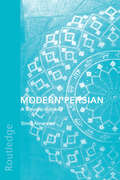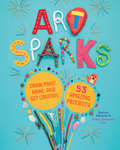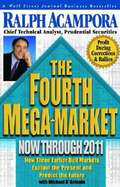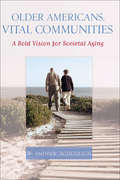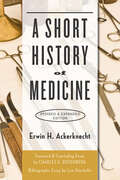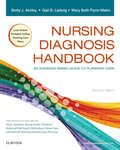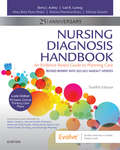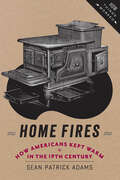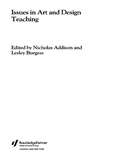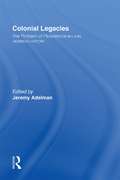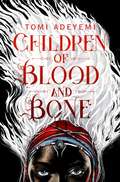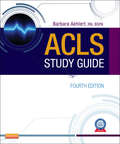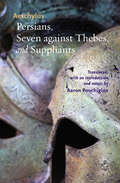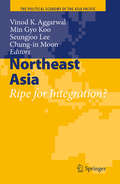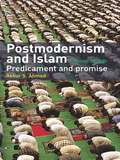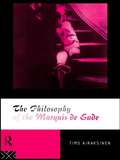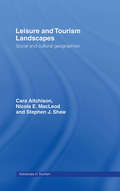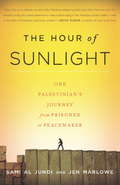- Table View
- List View
Piers Plowman: The A Version
by Mí 267 Eál F. VaughanThe fourteenth-century Piers Plowman is one of the most influential poems from the Age of Chaucer. Following the character Will on his quest for the true Christian life, the three dream narratives that make up this work address a number of pressing political, social, moral, and educational issues of the late Middle Ages. Míceál F. Vaughan presents a fresh edition of the A version, an earlier and shorter version of this great work.Unlike the B and C versions, there is no modern, affordable edition of the A version available. For the first time in decades, students and scholars of medieval literature now have access to this important work. Vaughan’s clean, uncluttered text is accompanied by ample glossing of difficult Middle English words. An expansive introduction, which includes a narrative summary of the poem, textual notes, detailed endnotes, and a select bibliography frame the text, making this edition ideal for classroom use.This is the first classroom edition of the A version since Thomas A. Knott and David C. Fowler’s celebrated 1952 publication. Based on an early-fifteenth-century manuscript from the University of Oxford’s Bodleian Library, Vaughan’s text offers a unique rendition of the poem, and it is the first modern edition not to attribute the poem to William Langland. By conservatively editing one important witness of Piers Plowman, Vaughan takes a new generation of students to an early version of this great medieval poem.
Abstractions and Embodiments: New Histories of Computing and Society (Studies in Computing and Culture)
by Janet Abbate Stephanie DickCutting-edge historians explore ideas, communities, and technologies around modern computing to explore how computers mediate social relations.Computers have been framed both as a mirror for the human mind and as an irreducible other that humanness is defined against, depending on different historical definitions of "humanness." They can serve both liberation and control because some people's freedom has historically been predicated on controlling others. Historians of computing return again and again to these contradictions, as they often reveal deeper structures.Using twin frameworks of abstraction and embodiment, a reformulation of the old mind-body dichotomy, this anthology examines how social relations are enacted in and through computing. The authors examining "Abstraction" revisit central concepts in computing, including "algorithm," "program," "clone," and "risk." In doing so, they demonstrate how the meanings of these terms reflect power relations and social identities. The section on "Embodiments" focuses on sensory aspects of using computers as well as the ways in which gender, race, and other identities have shaped the opportunities and embodied experiences of computer workers and users. Offering a rich and diverse set of studies in new areas, the book explores such disparate themes as disability, the influence of the punk movement, working mothers as technical innovators, and gaming behind the Iron Curtain. Abstractions and Embodiments reimagines computing history by questioning canonical interpretations, foregrounding new actors and contexts, and highlighting neglected aspects of computing as an embodied experience. It makes the profound case that both technology and the body are culturally shaped and that there can be no clear distinction between social, intellectual, and technical aspects of computing. Contributors: Janet Abbate, Marc Aidinoff, Troy Kaighin Astarte, Ekaterina Babinsteva, André Brock, Maarten Bullynck, Jiahui Chan, Gerardo Con Diaz, Liesbeth De Mol, Stephanie Dick, Kelcey Gibbons, Elyse Graham, Michael J. Halvorson, Mar Hicks, Scott Kushner, Xiaochang Li, Zachary Loeb, Lisa Nakamura, Tiffany Nichols, Laine Nooney, Elizabeth Petrick, Cierra Robson, Hallam Stevens, Jaroslav Švelch
The Cranks Bible: A Timeless Collection of Vegetarian Recipes
by Nadine AbensurA classic collection of healthy and delicious plant-based recipes from the Cranks kitchenSince opening their first restaurant in 1961, Cranks have been pioneers of vegetarian cuisine and champions of organic produce. Here, celebrated writer and chef Nadine Abensur presents over 200 classic meat-free recipes from the Cranks kitchen. From pumpkin and parsley risotto to aubergines with smoked ricotta, passion fruit ice-cream, walnut and raisin loaves and plum jam, every recipe is packed full of beautifully simple, natural ingredients that will nourish both body and soul. With advice on selecting the freshest seasonal produce, eating healthily and enjoying the experience of making mouth-watering food, THE CRANKS BIBLE is a celebration of vegetarian cooking and an essential resource for every home.
Revival: The Cambodian Agony (1990)
by David A. Ablin M. HoodThis title was first published in 1990: Cambodia, it has been said, has gone through the most radical social upheaval and transformation of any country in recorded history. From the overthrow of Prince Sihanouk, who ruled for 29 year, in 1970 to the victory of the Cambodian Communist Party in 1975, Cambodia suffered massive saturation bombing and an unusually violent civil war. It is estimated that half a million people of the seven million total population died. From 1975 to the end 1978 as many as another three million perished because of the brutal policies of the government, and spurred the civil war that has been simmering ever since. In this book, the world's leading experts on Cambodia and the politics of Indochina address the major issues facing Cambodia since the overthrow of the Pol Pot regime in 1978.
Modern Persian: A Course-Book
by Simin AbrahamsModern Persian begins with the teaching of the Persian alphabet. It aims to provide the student with the necessary skills for social interaction, as well as a basis for the study of modern literature. The course consists of seventeen units and favours teaching by communicative and contextual learning. Most units begin with a reading exercise used to introduce an item of grammar and new vocabulary, followed by explanations and drill exercises aimed at consolidating the student's understanding. Complete with Persian-English vocabulary to all the exercises and tape recordings, this is an up-to-date textbook which can be used both by teachers or individuals wishing to learn Persian independently.
Art Sparks: Draw, Paint, Make, and Get Creative with 53 Amazing Projects!
by Marion Abrams Hilary Emerson LayThis lively, colorful compendium of arts and crafts for a new generation of kids features projects specially designed to spark creativity, invite self-expression, and nurture self-confidence. From finger puppets to fabric flags to shrink art, each activity uses inexpensive materials and can be crafted in less than 90 minutes.
The Fourth Mega-Market, Now Through 2011: How Three Earlier Bull Markets Explain the Present and Predict the Future
by Ralph Acampora Michael D'AngeloA proven leader in the financial world explains the current bull market--and how to profit from it--by comparing it to the great bull markets of the past.Were you surprised by Wall Street's incredible performance over the past few years? Ralph Acampora wasn't. In fact, Acampora, Prudential's top technical analyst, predicted the current bullish trend--and helped countless clients profit from it. Now you can too.Acampora coined the term mega-market to describe a bull market that lasts a minimum of ten years and a maximum of eighteen years with Dow gains of between 400% and 500%. In The Fourth Mega-Market, Acampora helps readers take advantage of the staggering performance of the current market by showing its similarities with the three previous mega-markets in American history. In an entertaining and straight-forward style, and with a wealth of informative charts and graphs, he helps readers recognize patterns that can explain market performance, showing how to use technical analysis to "hear the voices" of the market. He offers valuable tips, such as how to spot and protect yourself from a correction; how psychology and politics influence the market; and how to analyze the performance of various market segments. Finally, he makes exciting predictions on just where the market will go before it ends and how it will get there, giving specific recommendations. While today's information overload keeps us on the edge of our seats, scanning the numbers for subtle clues as to the market's next seismic shift, Ralph Acampora shows us the value of a larger perspective, one that not only explains today's mega-market, but also shows us how to keep investing our money wisely and ride high on the current wave.
Older Americans, Vital Communities: A Bold Vision for Societal Aging
by W. Andrew AchenbaumThis thought-provoking work grapples with the vast range of issues associated with the aging population and challenges people of all ages to think more boldly and more creatively about the relationship between older Americans and their communities. W. Andrew Achenbaum begins by exploring the demographics of our aging society and its effect on employment and markets, education, health care, religion, and political action. Drawing on history, literature, and philosophy, Achenbaum focuses on the way health care and increases in life expectancy have transformed late life from a phase characterized by illness, frailty, and debility to one of vitality, productivity, and spirituality. He shows how this transformation of aging is beginning to be felt in programs and policies for aging persons, as communities focus more effort on lifelong learning and extensive civic engagement. Concerned that his own undergraduate students are too focused on the immediate future, Achenbaum encourages young people to consider their place in life's social and chronological trajectory. He calls on baby boomers to create institutional structures that promote productive, vital growth for the common good, and he invites people of all ages to think more boldly about what they will do with the long lives ahead of them.
A Short History of Medicine
by Erwin H. Ackerknecht Lisa Haushofer.Erwin H. Ackerknecht;€™s A Short History of Medicine is a concise narrative, long appreciated by students in the history of medicine, medical students, historians, and medical professionals as well as all those seeking to understand the history of medicine.Covering the broad sweep of discoveries from parasitic worms to bacilli and x-rays, and highlighting physicians and scientists from Hippocrates and Galen to Pasteur, Koch, and Roentgen, Ackerknecht narrates Western and Eastern civilization;€™s work at identifying and curing disease. He follows these discoveries from the library to the bedside, hospital, and laboratory, illuminating how basic biological sciences interacted with clinical practice over time. But his story is more than one of laudable scientific and therapeutic achievement. Ackerknecht also points toward the social, ecological, economic, and political conditions that shape the incidence of disease. Improvements in health, Ackerknecht argues, depend on more than laboratory knowledge: they also require that we improve the lives of ordinary men and women by altering social conditions such as poverty and hunger.This revised and expanded edition includes a new foreword and concluding biographical essay by Charles E. Rosenberg, Ackerknecht;€™s former student and a distinguished historian of medicine. A new bibliographic essay by Lisa Haushofer explores recent scholarship in the history of medicine.
A Short History of Medicine
by Erwin H. Ackerknecht Lisa Haushofer.Erwin H. Ackerknecht;€™s A Short History of Medicine is a concise narrative, long appreciated by students in the history of medicine, medical students, historians, and medical professionals as well as all those seeking to understand the history of medicine.Covering the broad sweep of discoveries from parasitic worms to bacilli and x-rays, and highlighting physicians and scientists from Hippocrates and Galen to Pasteur, Koch, and Roentgen, Ackerknecht narrates Western and Eastern civilization;€™s work at identifying and curing disease. He follows these discoveries from the library to the bedside, hospital, and laboratory, illuminating how basic biological sciences interacted with clinical practice over time. But his story is more than one of laudable scientific and therapeutic achievement. Ackerknecht also points toward the social, ecological, economic, and political conditions that shape the incidence of disease. Improvements in health, Ackerknecht argues, depend on more than laboratory knowledge: they also require that we improve the lives of ordinary men and women by altering social conditions such as poverty and hunger.This revised and expanded edition includes a new foreword and concluding biographical essay by Charles E. Rosenberg, Ackerknecht;€™s former student and a distinguished historian of medicine. A new bibliographic essay by Lisa Haushofer explores recent scholarship in the history of medicine.
Nursing Diagnosis Handbook - E-Book: An Evidence-Based Guide to Planning Care
by Betty J. Ackley Gail B. Ladwig Mary Beth MakicAckley’s Nursing Diagnosis Handbook: An Evidence-Based Guide to Planning Care, 11th Edition helps practicing nurses and nursing students select appropriate nursing diagnoses and write care plans with ease and confidence. This convenient handbook shows you how to correlate nursing diagnoses with known information about clients on the basis of assessment findings, established medical or psychiatric diagnoses, and the current treatment plan. Extensively revised and updated with the new 2015-2017 NANDA-I approved nursing diagnoses, it integrates the NIC and NOC taxonomies, evidence-based nursing interventions, and adult, pediatric, geriatric, multicultural, home care, and client/family teaching and discharge planning considerations to guide you in creating unique, individualized care plans.Comprehensive, up-to-date information on all the 2015-2017 NANDA-I nursing diagnoses so you stay in the know. UNIQUE! Provides care plans for every NANDA-I approved nursing diagnosis plus two unique care plans for Hearing Loss and Vision Loss.Includes pediatric, geriatric, multicultural, client/family teaching and discharge planning, home care, and safety interventions as necessary for plans of care. Presents examples of and suggested NIC interventions and NOC outcomes in each care plan. UNIQUE! Care Plan Constructor on the companion Evolve website offers hands-on practice creating customized plans of care.150 NCLEX exam-style review questions are available on Evolve.Promotes evidence-based interventions and rationales by including recent or classic research that supports the use of each intervention. Classic evidence-based references promote evidence-based interventions and rationales.Clear, concise interventions are usually only a sentence or two long and use no more than two references. Safety content emphasizes what must be considered to provide safe patient care. Step-by-step instructions show you how to use the Guide to Nursing Diagnoses and Guide to Planning Care sections to create a unique, individualized plan of care. List of Nursing Diagnosis Index in back inside cover of book for quick reference. Three-column index is easy to use. Easy-to-follow sections I and II guide you through the nursing process and selecting appropriate nursing diagnoses.Alphabetical thumb tabs allow quick access to specific symptoms and nursing diagnoses.
Nursing Diagnosis Handbook E-Book: An Evidence-Based Guide to Planning Care
by Betty J. Ackley Gail B. Ladwig Mary Beth Makic Marina Martinez-Kratz Melody ZanottiGet nursing care plans right! Ackley’s Nursing Diagnosis Handbook: An Evidence-Based Guide to Planning Care, 12th Edition helps practicing nurses and nursing students select appropriate nursing diagnoses and write care plans with ease and confidence. This convenient handbook shows you how to correlate nursing diagnoses with known information about clients on the basis of assessment findings, established medical or psychiatric diagnoses, and the current treatment plan. Extensively revised and updated with the new 2018-2020 NANDA-I approved nursing diagnoses, it integrates the NIC and NOC taxonomies, evidence-based nursing interventions, and adult, pediatric, geriatric, multicultural, home care, safety, and client/family teaching and discharge planning considerations to guide your students in creating unique, individualized care plans.Step-by-step instructions shows you how to use the Guide to Nursing Diagnoses and Guide to Planning Care sections to create a unique, individualized plan of care. UNIQUE! Provides care plans for every NANDA-I approved nursing diagnosisPromotes evidence-based interventions and rationales by including recent or classic research that supports the use of each intervention. Presents examples of and suggested NIC interventions and NOC outcomes in each care plan.150 NCLEX exam-style review questions are available on Evolve.Easy-to-follow sections I and II guide you through the nursing process and selection of appropriate nursing Appendixes provide you with valuable information in an easy-to-access location. Clear, concise interventions are usually only a sentence or two long and use no more than two references. Safety content emphasizes what must be considered to provide safe patient care. Classic evidence-based references promote evidence-based interventions and rationales.List of Nursing Diagnosis Index on inside front cover of book for quick reference. Alphabetical thumb tabs allow quick access to specific symptoms and nursing diagnoses.NEW! Includes comprehensive, up-to-date information on the new 2018-2020 NANDA-I approved nursing diagnoses, complete with 17 new diagnoses.NEW! and UPDATED! Provides the latest NIC/NO C, interventions, and rationales for every care planNEW! Section I: Gender identity discussion includes information about the caregiver’s responsibility for adapting care accordingly. NEW! Interventions reorganized by priority helps you quickly identify the information you’re searching for. NEW! Section II: Bullying, Gender Dysphoria, Medical marijuana, Military families/personnel, Opioid use/abuse, Service animals, Technology addiction, and Veterans.NEW! Additional clarification of use of QSEN throughout book in Section INEW! Concept map creator added from Yoost textbook. NEW! Updated rationales include evidence-based references 5 years or less.
Home Fires: How Americans Kept Warm in the Nineteenth Century (How Things Worked)
by Sean Patrick AdamsHome Fires tells the fascinating story of how changes in home heating over the nineteenth century spurred the growth of networks that helped remake American society. Sean Patrick Adams reconstructs the ways in which the "industrial hearth" appeared in American cities, the methods that entrepreneurs in home heating markets used to convince consumers that their product designs and fuel choices were superior, and how elite, middle-class, and poor Americans responded to these overtures.Adams depicts the problem of dwindling supplies of firewood and the search for alternatives; the hazards of cutting, digging, and drilling in the name of home heating; the trouble and expense of moving materials from place to place; the rise of steam power; the growth of an industrial economy; and questions of economic efficiency, at both the individual household and the regional level. Home Fires makes it clear that debates over energy sources, energy policy, and company profit margins have been around a long time.The challenge of staying warm in the industrializing North becomes a window into the complex world of energy transitions, economic change, and emerging consumerism. Readers will understand the struggles of urban families as they sought to adapt to the ever-changing nineteenth-century industrial landscape. This perspective allows a unique view of the development of an industrial society not just from the ground up but from the hearth up.
Home Fires: How Americans Kept Warm in the Nineteenth Century (How Things Worked)
by Sean Patrick AdamsHome Fires tells the fascinating story of how changes in home heating over the nineteenth century spurred the growth of networks that helped remake American society. Sean Patrick Adams reconstructs the ways in which the "industrial hearth" appeared in American cities, the methods that entrepreneurs in home heating markets used to convince consumers that their product designs and fuel choices were superior, and how elite, middle-class, and poor Americans responded to these overtures.Adams depicts the problem of dwindling supplies of firewood and the search for alternatives; the hazards of cutting, digging, and drilling in the name of home heating; the trouble and expense of moving materials from place to place; the rise of steam power; the growth of an industrial economy; and questions of economic efficiency, at both the individual household and the regional level. Home Fires makes it clear that debates over energy sources, energy policy, and company profit margins have been around a long time.The challenge of staying warm in the industrializing North becomes a window into the complex world of energy transitions, economic change, and emerging consumerism. Readers will understand the struggles of urban families as they sought to adapt to the ever-changing nineteenth-century industrial landscape. This perspective allows a unique view of the development of an industrial society not just from the ground up but from the hearth up.
Issues in Art and Design Teaching
by Nicholas Addison Lesley BurgessIssues in Art and Design Teaching draws together a range of pedagogical and ethical issues for trainee and newly qualified teachers of art and design, and their mentors in art and design education. Arguing for a critical approach to the art and design curriculum, the collection encourages students and teachers to consider and reflect on issues in order that they can make reasoned and informed judgments about their teaching of art and design.Among the key issues addressed include: challenging orthodoxies and exploring contemporary practices measuring artistic performance art history and multicultural education research in art and design education transitions in art and design education: primary/secondary and secondary/tertiary the role of art and design in citizenship education.
Colonial Legacies: The Problem of Persistence in Latin American History
by Jeremy AdelmanMore than other Atlantic societies, Latin America is shackled to its past. This collection is an exploration of the binding historical legacies--the making of slavery, patrimonial absolutist states, backward agriculture and the imprint of the Enlightenment--with which Latin America continues to grapple.Leading writers and scholars reflect on how this heritage emerged from colonial institutions and how historians have tackled these legacies over the years, suggesting that these deep encumbrances are why the region has failed to live up to liberal-capitalist expectations. They also invite discussion about the political, economic and cultural heritages of Atlantic colonialism through the idea that persistence is a powerful organizing framework for understanding particular kinds of historical processes.
Children of Blood and Bone (Legacy of Orisha #1)
by Tomi AdeyemiWinner of the Tonight Show Summer Reads with Jimmy Fallon.Tomi Adeyemi conjures a stunning world of dark magic and danger in her West African-inspired fantasy debut Children of Blood and Bone.They killed my mother.They took our magic.They tried to bury us. Now we rise. Zélie remembers when the soil of Orïsha hummed with magic. When different clans ruled – Burners igniting flames, Tiders beckoning waves, and Zélie’s Reaper mother summoning forth souls.But everything changed the night magic disappeared. Under the orders of a ruthless king, anyone with powers was targeted and killed, leaving Zélie without a mother and her people without hope. Only a few people remain with the power to use magic, and they must remain hidden. Zélie is one such person. Now she has a chance to bring back magic to her people and strike against the monarchy. With the help of a rogue princess, Zélie must learn to harness her powers and outrun the crown prince, who is hell-bent on eradicating magic for good. Danger lurks in Orïsha, where strange creatures prowl, and vengeful spirits wait in the waters. Yet the greatest danger may be Zélie herself as she struggles to come to terms with the strength of her magic – and her growing feelings for an enemy.The movie of Children of Blood and Bone is in development at Fox 2000/Temple Hill Productions with the incredible Karen Rosenfelt and Wyck Godfrey (Twilight, Maze Runner, The Fault In Our Stars) producing it.
ACLS Study Guide - E-Book: Quick Review Study Guide
by Barbara J AehlertReflecting the 2010 Emergency Cardiovascular Care guidelines, ACLS Study Guide, 4th Edition offers a complete, full-color overview of advanced cardiovascular life support. An easy-to-read approach covers everything from airway management and rhythms and their management to electrical therapy, acute coronary syndromes, and acute stroke. In addition to the latest ACLS treatment algorithms, this edition includes new case studies, new photos and illustrations, a heart rate ruler, and a handy ACLS quick-reference card for use in the field. Written by Barbara Aehlert, ACLS Study Guide is the official textbook for the American Safety & Health Institute ACLS certification course.A pretest and posttest -- each containing 50 questions with answers and rationales -- allow you to check your knowledge prior to and after your study. Chapter objectives preview the main points in each chapter. Stop and Review sections at the end of the chapters help you remember the most important information. ACLS Pearls boxes offer key points and useful tips for clinical practice. Keeping it Simple boxes provide essential information in a clear and concise manner. Ten case studies present real-life clinical situations, allowing you to make decisions based on information in the Preparatory section. Consistent format of case studies includes Objective, Skills to Master, Rhythms to Master, Medications to Master, Related Text Chapters, Essential Actions, and Unacceptable Actions. A heart rate ruler is included to help you interpret ECGs. 4 x 6 pocket-size quick-reference card contains key ACLS algorithms for field use. 100 new and updated photos and illustrations show key ACLS procedures and equipment. Pharmacological interventions are integrated into the chapters for a more cohesive learning experience. New streamlined approach reduces the number of pages and simplifies the information you need to know.
Persians, Seven against Thebes, and Suppliants (Johns Hopkins New Translations from Antiquity)
by AeschylusAaron Poochigian’s new translations of Aeschylus’s earliest extant plays provide the clearest rendering yet of their formal structure. The distinction between spoken and sung rhythms is as sharp as it is in the source texts, and for the first time readers in English can fully grasp the balanced, harmonious arrangement of choral odes. The importance of these works to the history of drama and tragedy and to the history of classical literature is beyond question, and their themes of military hubris and foreign versus native are deeply relevant today. Persians offers a surprisingly sympathetic portrayal of the Athenians’ most hated enemy; in Seven against Thebes Argive invaders, though no less Greek than the Thebans themselves, are portrayed as barbarians; and in Suppliants the city of Argos is called upon to protect Egyptian refugees. Based on textual evidence and the archaeological remains of the Theater of Dionysus at Athens, Poochigian’s introductory overview of stage properties and accompanying stage directions allow readers to experience the plays as they were performed in their own time. He is most careful in his translations of the plays’ choral odes. Instead of rendering them with little or no form, Poochigian has preserved the comprehensive structures Aeschylus himself employed. Readers are thus able to recognize Aeschylus as a master of poetry as well as of drama. Poochigian’s translations are the most accurate renditions of the poetry and dramaturgy of the original works available. Intended to be both read as literature and performed as plays, these translations are lucid and readable, while remaining staunchly faithful to the texts.
Northeast Asia: Ripe for Integration? (The Political Economy of the Asia Pacific)
by Vinod K. Aggarwal Seungjoo Lee Min Gyo Koo Chung-In MoonCan regional mechanisms better institutionalize the increasing complexity of economic and security ties among the countries in Northeast Asia? As the international state system undergoes dramatic changes in both security and economic relations in the wake of the end of the Cold War, the Asian financial crisis, and the attack of 9/11, this question is now at the forefront of the minds of both academics and policymakers. Still, little research has been done to integrate the analysis of security and economic analysis of changes in the region within a broader context that will give us theoretically-informed policy insights. Against this backdrop, this book investigates the origins and evolution of Northeast Asia's new institutional architecture in trade, finance, and security from both a theoretical and empirical perspective.
Postmodernism and Islam: Predicament and Promise
by Akbar S. AhmedCan West and East ever understand each other? In this extraordinary book one of the world's leading Muslim scholars explores an area which has which has been almost entirely neglected by scholars in the field - the area of postmodernism and Islam. This landmark work is startling, constantly perceptive and certain to be debated for years to come.
The Philosophy of the Marquis de Sade
by Timo AiraksinenThe Marquis de Sade is famous for his forbidden novels like Justine, Juliette, and the 120 Days of Sodom. Yet, despite Sade's immense influence on philosophy and literature, his work remains relatively unknown. His novels are too long, repetitive, and violent. At last in The Philosophy of the Marquis de Sade, a distinguished philosopher provides a theoretical reading of Sade. Airaksinen examines Sade's claim that in order to be happy and free we must do evil things. He discusses the motivations of the typical Sadean hero, who leads a life filled with perverted and extreme pleasures, such as stealing, murder, rape, and blasphemy. Secondary sources on Sade, such as Hobbes, Erasmusm, and Brillat-Savarin are analyzed, and modern studies are evaluated. The Philosophy of the Marquis de Sade greatly enhances our understanding of Sade and his philosophy of pain and perversion.
Leisure and Tourism Landscapes: Social and Cultural Geographies (Routledge Advances in Tourism #No.9)
by Cara Aitchison Nicola E. MacLeod Nicola E Macleod Stephen J. ShawIncreasingly significant as mediators of spatial identity and meaning, leisure, tourism, culture and heritage are only now beginning to be located within the rapidly evolving discourses of poststructuralist geographies. Exploring the influence of leisure and tourism on the production, representation and consumption of landscape, the first half of this important book focuses on different ways of ‘seeing’ or representing landscape, whereas the second half examines different forms of productive consumption in leisure and tourism. Both symbolic and material spaces of leisure and tourism are also examined in relation to urban and rural landscapes, heritage landscapes, gendered landscapes, and landscapes of sexuality and desire. With a multidisciplinary approach and a strong theoretical content which builds on poststructuralist theories, this is undoubtedly an important addition to literature in the field.
The Hour of Sunlight: One Palestinian's Journey from Prisoner to Peacemaker
by Sami al Jundi Jen MarloweAs a teenager in Palestine, Sami al Jundi had one ambition: overthrowing Israeli occupation. With two friends, he began to build a bomb to use against the police. But when it exploded prematurely, killing one of his friends, al Jundi was caught and sentenced to ten years in prison. It was in an Israeli jail that his unlikely transformation began. Al Jundi was welcomed into a highly organized, democratic community of political prisoners who required that members of their cell read, engage in political discourse on topics ranging from global revolutions to the precepts of nonviolent protest and revolution.Al Jundi left prison still determined to fight for his people's rights-but with a very different notion of how to undertake that struggle. He cofounded the Middle East program of Seeds of Peace Center for Coexistence, which brings together Palestinian and Israeli youth.Marked by honesty and compassion for Palestinians and Israelis alike, The Hour of Sunlight illuminates the Palestinian experience through the story of one man's struggle for peace.
The Hour of Sunlight: One Palestinian's Journey from Prisoner to Peacemaker
by Sami al Jundi Jen MarloweAs a teenager in Palestine, Sami al Jundi had one ambition: overthrowing Israeli occupation. With two friends, he began to build a bomb to use against the police. But when it exploded prematurely, killing one of his friends, al Jundi was caught and sentenced to ten years in prison. It was in an Israeli jail that his unlikely transformation began. Al Jundi was welcomed into a highly organized, democratic community of political prisoners who required that members of their cell read, engage in political discourse on topics ranging from global revolutions to the precepts of nonviolent protest and revolution. Al Jundi left prison still determined to fight for his people's rights -- but with a very different notion of how to undertake that struggle. He cofounded the Middle East program of Seeds of Peace Center for Coexistence, which brings together Palestinian and Israeli youth. Marked by honesty and compassion for Palestinians and Israelis alike, The Hour of Sunlight illuminates the Palestinian experience through the story of one man's struggle for peace.
